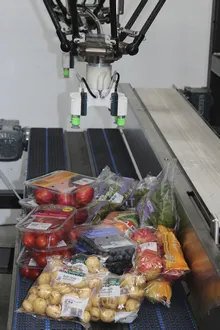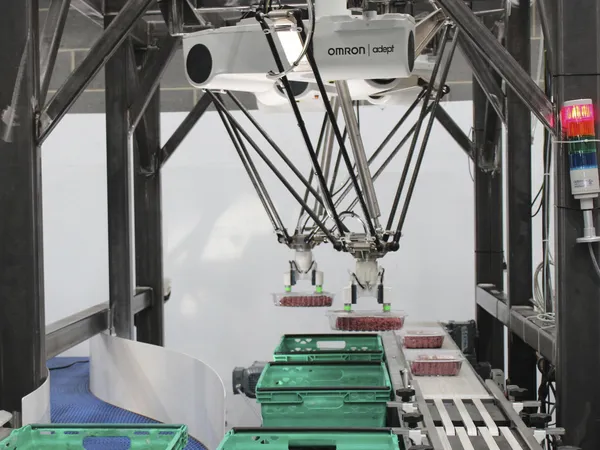Unlike many of our European counterparts, the UK has been slow to automate. But a perfect storm of Brexit and Covid-19 is set to fast-track our robotics revolution. Here, David Jahn, Director of Brillopak, explains how 2021 is poised to become the year that robotic arms finally replace human hands at food manufacturing sites’ end of line packing operation.
Loss of labour
Since the early noughties, the UK has relied on a steady stream of cheap European workers to support our food and agricultural sectors. But following the EU referendum in 2016, these numbers have been dwindling; in 2019, the ONS reported that National Insurance numbers allocated to EU citizens dropped by 28% from 2015, and arrivals of EU citizens planning to spend at least 12 months in the UK fell by 34%. The offer of a seasonal job with low pay, long hours and accommodation that takes the applicant away from their homes and families for long periods of time doesn’t quite cut it for Brits and doesn’t have them signing up in droves. There is a reason why the sector is so reliant on migrant labour. To put it bluntly, the supply of good-quality, affordable labour to support the requirements of our food sector is drying up.
The obvious solution is to automate, particularly for the more repetitive and physically demanding end-of-line tasks, such as picking, packing and palletising. But despite the labour challenges faced by the industry, The Engineer reported in 2019 that 57% of businesses were still unwilling to invest in automation equipment and a further 27% were unwilling to change production processes.
Reaching the tipping point Then in 2020, the entire landscape shifted. The Covid-19 pandemic has forced companies to decrease the number of employees on site and ensure that social distancing can be maintained for those that remain. The lockdown has also made foreign travel a near impossibility, further depleting the number of European workers available for hire. For labour-intensive packhouses, often comprising large numbers of foreign employees within a tight space, this presents an unprecedented challenge. There is without doubt a nervousness about what looms for 2021’s picking season. Despite the government’s best efforts with their Pick for Britain campaign to invoke the spirit of the Land Army amongst the British people, people working on farms will return to their original roles and this pool of labour will no longer be available.
Then in 2020, the entire landscape shifted. The Covid-19 pandemic has forced companies to decrease the number of employees on site and ensure that social distancing can be maintained for those that remain. The lockdown has also made foreign travel a near impossibility, further depleting the number of European workers available for hire. For labour-intensive packhouses, often comprising large numbers of foreign employees within a tight space, this presents an unprecedented challenge. There is without doubt a nervousness about what looms for 2021’s picking season. Despite the government’s best efforts with their Pick for Britain campaign to invoke the spirit of the Land Army amongst the British people, people working on farms will return to their original roles and this pool of labour will no longer be available.
The benefits of replacing manual workers with robots are widely known – increased efficiency, consistent output and a rise in productivity, to name a few. But automation now offers the potential for food manufacturers to create a more Covid-friendly work environment and redeploy the scarce labour that remains to more business-critical tasks, such as nurturing and collecting crops in the field.
Previous concerns over size and cost can also be negated. Today’s end-of-line robot systems can easily fit into a tight footprint and can deliver a return on investment within just a few years. Not only is this due to the fact that automation increases throughput, thereby boosting production levels, but also because it removes repetitive, arduous tasks which lead to absenteeism. High levels of absence mean firms need to employ more staff to deliver the same output, as well as increase management overheads to control resources.
Ensuring flexibility
The case for automation is therefore more persuasive in 2021 than ever before, but there is a key downside to a reduction in personnel – plenty of people means plenty of flexibility. If labour is to be successfully replaced by machines, then the machines must be able to replicate this flexibility. For example, can a robot gently handle multiple differently shaped products, without causing damage, at a consistently high speed throughout a shift?
For one of Tesco’s top apple suppliers, Adrian Scripps, this focus on flexibility was crucial and played a key role in its decision to automate. The company doubled its hectare productivity over the last 15 years and needed to upgrade its packing facility to accommodate the increased throughput. “In 2013, our facility processed approximately 30,000 boxes of apples and pears every week,” says James Simpson, Managing Director. “Now, typical weekly production is 80-100,000 boxes a week.”

Automation in action
Adrian Scripps chose to partner with Brillopak and now employs four UniPAKer automated crate loading cells, each housing two delta-type robots. While the labour-saving benefits of automating were clear – productivity has increased three-fold – it was the UniPAKer’s inherent flexibility that sealed the deal: “We looked at mechanical systems where the pack is turned to orientate it, but the flexibility of the UniPAKer won us over,” explains James. “It is infinitely programmable and allows you to make very small adjustments to get the pack to the exact target location. Apples are not an easy fruit to handle because they bruise very easily. This, combined with the need to execute a range of crate patterns, made this project a challenge that couldn’t be met by a mechanical system.”
It is clear, therefore, that today’s automated solutions are much more than just a robotic replacement for a manual worker. Extremely compact, hygienic, and with the ability to pick and place consistently and accurately at high speed, the best examples also offer food manufacturers complete production flexibility. While first Brexit and now Covid have presented our industry with extraordinary challenges, they may also prove the catalysts for welcome change, prompting food producers to enjoy all the benefits that automation has to offer.
For more information:
David Jahn
Brillopak
Tel: +44 1622 872907
www.brillopak.co.uk
